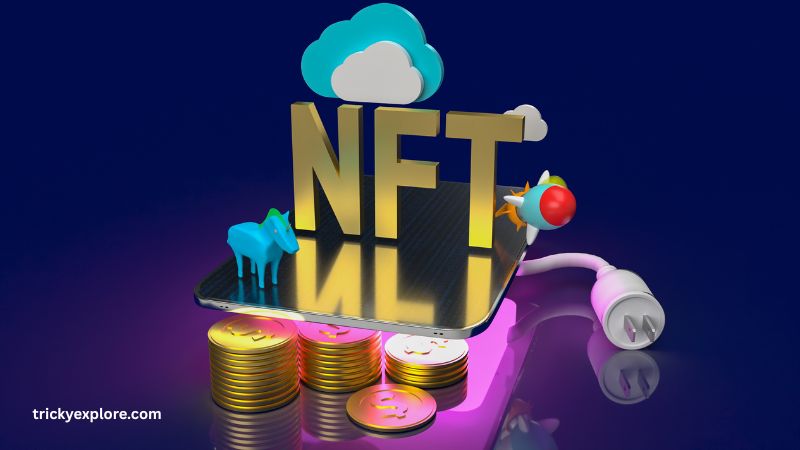Blockchain technology has emerged as a revolutionary force, reshaping the way we perceive and interact with digital systems. From financial services to supply chain management, its applications are vast and transformative. But what exactly is blockchain, and why is it garnering so much attention?
Imagine a world where transactions are transparent, data is immutable, and trust is established without intermediaries. This is the promise of blockchain technology. By providing a decentralized and secure platform, it eliminates the need for traditional gatekeepers, fostering efficiency and trust in various sectors.
In this comprehensive guide, we’ll delve deep into the intricacies of blockchain technology, exploring its components, functionalities, and the myriad ways it’s poised to redefine our digital landscape.
Table of Contents
ToggleWhat is Blockchain Technology?

At its core, blockchain is a distributed ledger technology that records transactions across multiple computers, ensuring that the recorded information cannot be altered retroactively. This decentralized nature eliminates the need for a central authority, making processes more transparent and secure.
The concept of blockchain was introduced in 2008 by an individual or group under the pseudonym Satoshi Nakamoto, primarily as the underlying technology for Bitcoin. However, its potential extends far beyond cryptocurrencies. Industries like healthcare, logistics, and real estate are exploring blockchain to enhance transparency, reduce fraud, and streamline operations.
Key characteristics of blockchain include:
Decentralization: No single entity controls the data.
Immutability: Once data is recorded, it cannot be altered.
Transparency: All participants can view the transactions.
Security: Advanced cryptographic techniques protect data integrity.
Understanding these foundational elements is crucial as we explore the deeper facets of blockchain technology.
How Does Blockchain Work?
To grasp the functionality of blockchain, envision a digital ledger where transactions are grouped into blocks. Each block contains a list of transactions, a timestamp, and a reference to the previous block, forming a chain—hence the name “blockchain.”
Here’s a step-by-step breakdown:
Transaction Initiation: A user initiates a transaction, such as sending cryptocurrency.
Broadcast to Network: The transaction is broadcasted to a network of nodes (computers).
Validation: Nodes validate the transaction using consensus mechanisms.
Block Formation: Validated transactions are grouped into a block.
Hashing: The block is hashed, creating a unique identifier.
Chain Linking: The new block is linked to the previous one, forming a chain.
Distribution: The updated blockchain is distributed across the network.
This process ensures that all participants have a synchronized and tamper-proof record of transactions. The decentralized and transparent nature of blockchain makes it a robust solution for various applications.
Key Components of Blockchain
Understanding the components of blockchain is essential to appreciate its functionality:
Blocks and Chains
Block: Contains a list of transactions, a timestamp, and a reference to the previous block.
Chain: A series of blocks linked together, forming the blockchain.
Hash Functions
A hash function converts input data into a fixed-size string of characters, which appears random. In blockchain:
Ensures data integrity.
Any change in input data results in a completely different hash.
Links blocks securely, as each block contains the hash of the previous one.
Consensus Mechanisms
These are protocols that ensure all nodes in the network agree on the blockchain’s current state. Common mechanisms include:
Proof of Work (PoW): Requires solving complex mathematical problems.
Proof of Stake (PoS): Validators are chosen based on the number of coins they hold.
Delegated Proof of Stake (DPoS): Stakeholders vote for delegates to validate transactions.
These components work in harmony to ensure the security, transparency, and efficiency of blockchain systems.
Types of Blockchain
Blockchain networks can be categorized based on their accessibility and control mechanisms:
Public Blockchain
Open to All: Anyone can join and participate.
Examples: Bitcoin, Ethereum.
Advantages: High transparency and decentralization.
Challenges: Scalability and energy consumption.
Private Blockchain
Restricted Access: Only authorized participants can join.
Controlled by: A single organization.
Advantages: Enhanced privacy and faster transactions.
Challenges: Centralization risks.
Consortium Blockchain
Semi-Decentralized: Controlled by a group of organizations.
Examples: Hyperledger, Corda.
Advantages: Combines benefits of public and private blockchains.
Challenges: Complex governance structures.
Each type serves specific use cases, and the choice depends on the requirements of the intended application.
Cryptocurrencies and Blockchain

Cryptocurrencies are perhaps the most well-known application of blockchain technology. They represent a significant shift in how we perceive and handle money, offering a decentralized alternative to traditional fiat currencies.
What Are Cryptocurrencies?
Cryptocurrencies are digital or virtual currencies that use cryptography for security. Unlike traditional currencies issued by governments (fiat currencies), cryptocurrencies operate on decentralized networks based on blockchain technology. This decentralization means that no single entity controls the currency, making transactions more transparent and resistant to censorship.
Popular Cryptocurrencies
Bitcoin (BTC): The first and most well-known cryptocurrency, introduced in 2009 by an anonymous entity known as Satoshi Nakamoto. Bitcoin paved the way for the development of other cryptocurrencies and remains a benchmark in the crypto world.
Ethereum (ETH): Launched in 2015, Ethereum introduced the concept of smart contracts, allowing developers to build decentralized applications (dApps) on its platform.
Ripple (XRP): Known for its digital payment protocol more than its cryptocurrency, Ripple facilitates fast and low-cost international money transfers.
Litecoin (LTC): Created as the “silver” to Bitcoin’s “gold,” Litecoin offers faster transaction times and a different hashing algorithm.
Cardano (ADA): Focused on sustainability and scalability, Cardano aims to provide a balanced and secure infrastructure for decentralized applications.
Benefits of Cryptocurrencies
Decentralization: Eliminates the need for intermediaries like banks, reducing transaction costs and increasing accessibility.
Transparency: All transactions are recorded on a public ledger, enhancing trust among users.
Security: Advanced cryptographic techniques ensure the integrity and security of transactions.
Accessibility: Cryptocurrencies can be accessed and used by anyone with an internet connection, promoting financial inclusion.
Challenges and Considerations
Volatility: Cryptocurrency prices can be highly volatile, posing risks for investors and users.
Regulatory Uncertainty: The legal status of cryptocurrencies varies across countries, affecting their adoption and use.
Security Risks: While blockchain is secure, exchanges and wallets can be vulnerable to hacks and scams.
Environmental Concerns: Some cryptocurrencies, like Bitcoin, require significant energy for mining, raising environmental issues.
Cryptocurrencies continue to evolve, with ongoing debates about their role in the financial system, regulatory frameworks, and technological advancements shaping their future.
Smart Contracts

Smart contracts are self-executing contracts with the terms of the agreement directly written into code. They run on blockchain networks, ensuring that once predefined conditions are met, the contract executes automatically without the need for intermediaries.
How Do Smart Contracts Work?
Smart contracts operate on an “if-then” basis. For example:
If a customer pays for a service,
Then the service is automatically delivered.
This automation reduces the need for manual processing, minimizes errors, and enhances efficiency.
Use Cases of Smart Contracts
Financial Services: Automating loan approvals, insurance claims, and trade settlements.
Supply Chain Management: Tracking goods from origin to delivery, ensuring transparency and authenticity.
Real Estate: Facilitating property transactions by automating the transfer of ownership and funds.
Healthcare: Managing patient consent and sharing medical records securely.
Voting Systems: Ensuring transparent and tamper-proof elections.
Advantages of Smart Contracts
Efficiency: Automates processes, reducing time and costs.
Transparency: All parties have access to the contract terms and execution history.
Security: Data is encrypted and stored on the blockchain, making it tamper-resistant.
Trust: Eliminates the need for intermediaries, reducing the risk of manipulation.
Challenges and Limitations
Immutability: Once deployed, smart contracts cannot be altered, which can be problematic if errors exist in the code.
Legal Recognition: The legal status of smart contracts varies, and they may not be enforceable in all jurisdictions.
Complexity: Writing secure and error-free smart contracts requires specialized knowledge.
Smart contracts hold the potential to revolutionize various industries by streamlining processes, reducing costs, and enhancing trust among parties.
Decentralization

Decentralization is a fundamental principle of blockchain technology, referring to the distribution of authority, data, and operations across a network rather than relying on a central entity.
Why Is Decentralization Important?
Resilience: Decentralized systems are less prone to single points of failure, enhancing system robustness.
Security: Distributing data across multiple nodes makes it more difficult for malicious actors to compromise the system.
Transparency: All participants have access to the same data, fostering trust.
Censorship Resistance: No central authority can unilaterally alter or suppress information.
Applications of Decentralization
Finance: Decentralized finance (DeFi) platforms offer financial services without traditional intermediaries.
Social Media: Decentralized platforms aim to give users control over their data and content.
Cloud Storage: Decentralized storage solutions distribute data across multiple nodes, enhancing security and accessibility.
Governance: Decentralized autonomous organizations (DAOs) enable collective decision-making without centralized leadership.
Challenges of Decentralization
Scalability: Decentralized networks can face difficulties in handling large volumes of transactions efficiently.
Coordination: Achieving consensus among distributed nodes can be complex.
Regulatory Compliance: Decentralized systems may struggle to adhere to existing legal frameworks.
User Experience: Decentralized applications may have steeper learning curves compared to centralized counterparts.
Despite these challenges, decentralization remains a cornerstone of blockchain technology, offering a paradigm shift in how systems are designed and operated.
NFTs (Non-Fungible Tokens)

Non-fungible tokens (NFTs) are unique digital assets that represent ownership of a specific item or piece of content, verified through blockchain technology.
Understanding NFTs
Unlike cryptocurrencies, which are fungible and can be exchanged on a one-to-one basis, NFTs are unique and cannot be exchanged on a like-for-like basis. Each NFT has distinct information or attributes that make it different from others.
Common Uses of NFTs
Digital Art: Artists can tokenize their work, providing proof of authenticity and ownership.
Collectibles: Digital trading cards, virtual pets, and other collectibles can be represented as NFTs.
Gaming: In-game items, characters, and assets can be owned and traded as NFTs.
Music and Videos: Musicians and content creators can sell their work directly to fans as NFTs.
Virtual Real Estate: Ownership of virtual land or property in digital environments.
Benefits of NFTs
Ownership Verification: Blockchain ensures the authenticity and provenance of digital assets.
Creator Empowerment: Artists and creators can monetize their work directly, bypassing traditional intermediaries.
Programmability: NFTs can include smart contracts that, for example, provide creators with royalties on secondary sales.
Criticisms and Concerns
Environmental Impact: Some NFT platforms use energy-intensive blockchain networks.
Speculation: The NFT market has seen significant price volatility and speculative behavior.
Intellectual Property Issues: Questions arise regarding the rights associated with NFT ownership.
NFTs have opened new avenues for digital ownership and monetization, though they also raise important questions about sustainability, legality, and value.
Interoperability in Blockchain
Interoperability refers to the ability of different blockchain networks to communicate and interact with each other, enabling seamless data and value transfer across platforms.
Why Is Interoperability Important?
Ecosystem Integration: Users and developers can leverage multiple blockchain platforms without being confined to one.
Efficiency: Facilitates faster and more cost-effective transactions across different networks.
Innovation: Encourages the development of applications that can operate across various blockchains.
Approaches to Achieving Interoperability
Cross-Chain Bridges: Connect two or more blockchains, allowing assets and data to move between them.
Sidechains: Independent blockchains that run in parallel to the main chain, enabling asset transfers.
Interoperability Protocols: Standards and protocols designed to facilitate communication between blockchains.
Challenges in Interoperability
Security Risks: Bridges and interoperability solutions can be targets for attacks.
Complexity: Ensuring compatibility between different blockchain architectures can be technically challenging.
Standardization: Lack of universal standards can hinder seamless integration.
Interoperability is crucial for the maturation of the blockchain ecosystem, enabling a more connected and versatile digital landscape.
Zero Knowledge Proofs

Zero Knowledge Proofs (ZKPs) are one of the most fascinating advancements in blockchain technology. They allow one party (the prover) to prove to another (the verifier) that a statement is true without revealing any information beyond the validity of the statement itself.
How Do Zero Knowledge Proofs Work?
Imagine trying to prove that you know a password without revealing the password itself. Zero Knowledge Proofs accomplish this through sophisticated cryptographic methods, ensuring privacy and security at the same time.
There are three main properties of ZKPs:
Completeness: If the statement is true, the verifier will be convinced.
Soundness: If the statement is false, the verifier won’t be fooled.
Zero-knowledge: No information about the actual statement is revealed.
Applications of Zero Knowledge Proofs in Blockchain
Private Transactions: Cryptocurrencies like Zcash use ZKPs to ensure transaction details are hidden while still being verifiable.
Identity Verification: Users can prove they meet certain criteria (age, nationality) without exposing sensitive information.
Secure Voting Systems: Voters can prove they voted without revealing who they voted for.
Advantages of Zero Knowledge Proofs
Enhanced Privacy: Protects sensitive information.
Increased Trust: Builds trust without compromising on secrecy.
Regulatory Compliance: Helps meet privacy regulations without revealing customer data.
Challenges of Zero Knowledge Proofs
Complexity: Developing and implementing ZKPs is highly complex and resource-intensive.
Performance: Can slow down transaction speeds if not optimized properly.
Zero Knowledge Proofs are a powerful tool for making blockchain applications more private and secure, providing essential functionality for the next generation of decentralized apps and financial systems.
Sustainable Blockchain
As blockchain adoption grows, so do concerns about its environmental impact. Bitcoin mining alone consumes more energy annually than some entire countries. Hence, the call for sustainable blockchain solutions is louder than ever.
Why is Sustainability a Concern?
High Energy Consumption: Proof-of-Work (PoW) based blockchains require immense computing power.
Carbon Footprint: Mining operations often rely on non-renewable energy sources.
Electronic Waste: Mining hardware becomes obsolete quickly, leading to environmental hazards.
Solutions for a Sustainable Blockchain Future
Transition to Proof-of-Stake (PoS): Unlike PoW, PoS consumes far less energy. Ethereum’s move to PoS (Ethereum 2.0) is a significant step forward.
Use of Renewable Energy: Mining operations powered by solar, wind, or hydroelectric energy can drastically cut emissions.
Carbon Offsetting Initiatives: Some blockchain projects invest in reforestation and renewable energy to offset their carbon footprints.
Projects Leading the Way
Algorand: Claims to be the world’s first carbon-negative blockchain.
Chia: Introduces a ‘Proof of Space and Time’ model to minimize energy use.
Energy Web: Focuses on accelerating the low-carbon, customer-centric electricity system.
Benefits of Sustainable Blockchain
Positive Brand Image: Companies aligning with environmental goals gain public trust.
Regulatory Advantage: Easier to comply with environmental regulations.
Long-Term Viability: Reduces dependency on unsustainable resources.
Sustainable blockchain practices are no longer optional—they’re essential for the technology’s long-term survival and global acceptance.
Security in Blockchain

Security is arguably one of the biggest selling points of blockchain technology. But how does blockchain achieve this high level of protection?
How Does a Hash Help Secure Blockchain Technology?
At the heart of blockchain security is the hash function. A hash is a unique string of characters generated by an algorithm based on input data. Even a small change in the input produces a drastically different hash, making tampering immediately detectable.
Each block contains:
The hash of its data.
The hash of the previous block.
Its own unique hash.
Thus, altering any information in a block would require changing the hashes of all subsequent blocks, an almost impossible task without controlling the majority of the network.
Other Key Security Features
Decentralization: No central point of failure.
Consensus Mechanisms: Ensure that only valid transactions are recorded.
Cryptographic Techniques: Protect the confidentiality and integrity of data.
Common Threats and Risks
51% Attacks: If a malicious actor controls more than half of the network’s power, they can manipulate the blockchain.
Phishing and Scams: Users are often the weakest link.
Smart Contract Vulnerabilities: Bugs in smart contract code can lead to major losses.
Best Practices for Blockchain Security
Regular Audits: Smart contracts and blockchain networks should undergo frequent security checks.
Multi-Factor Authentication: Enhances account security.
Cold Storage Wallets: Storing cryptocurrency offline reduces hacking risks.
Security is the foundation upon which blockchain’s trustless systems are built. Without it, the integrity and future of the technology would be at risk.
Challenges in Blockchain Adoption
Despite its incredible promise, blockchain faces numerous hurdles before achieving widespread adoption.
Scalability Issues
Blockchain networks like Bitcoin and Ethereum struggle with transaction speeds compared to traditional systems like Visa. Solutions like layer-2 scaling (e.g., Lightning Network) are in progress but not yet mainstream.
Regulatory Uncertainty
Governments worldwide are grappling with how to regulate blockchain:
Some embrace it with open arms.
Others issue outright bans.
Most are somewhere in between.
Lack of clear regulations creates uncertainty for developers, investors, and users.
Interoperability Challenges
Different blockchains often operate in isolation, hindering communication and collaboration between networks.
Public Perception
Complexity: The technology is often perceived as too complicated for the average user.
Association with Crime: Blockchain’s use in illicit activities has tainted its image.
Environmental Concerns
As discussed earlier, the environmental impact of blockchain technologies has attracted criticism and slowed adoption.
Cost
Setting up and maintaining blockchain infrastructure can be expensive, making it less attractive for small and medium-sized enterprises (SMEs).
Solutions for Overcoming Challenges
Better User Interfaces: Simplifying blockchain apps for the general public.
Clear Regulations: Governments working closely with industry stakeholders.
Environmental Innovations: Moving toward greener blockchain solutions.
Blockchain has the potential to reshape industries, but overcoming these challenges is crucial for it to achieve global mainstream success.
Future of Blockchain Technology

The future of blockchain looks incredibly promising, with new use cases and technologies emerging every day.
Emerging Trends
Web3: The next evolution of the internet, built on blockchain, promises a more user-centric and decentralized web.
Decentralized Finance (DeFi): Financial systems without banks and brokers are becoming more sophisticated and secure.
Blockchain in IoT: Secure, decentralized communication between IoT devices.
Tokenization of Assets: Real estate, art, and even stocks are being tokenized to allow fractional ownership and increased liquidity.
Industries Likely to Be Disrupted
Healthcare: Secure patient data sharing.
Supply Chain: Transparent and verifiable product tracking.
Entertainment: Direct creator-to-consumer models.
Voting Systems: Tamper-proof, transparent elections.
Potential Challenges Ahead
Regulation: Striking the right balance between innovation and compliance.
Interoperability: Ensuring different blockchains can work together seamlessly.
Security: Staying ahead of increasingly sophisticated cyber threats.
Conclusion of Blockchain Technology
Blockchain technology is more than just the foundation of cryptocurrencies; it’s a revolution in how we store, share, and secure information. With its core principles of decentralization, transparency, and security, blockchain is poised to disrupt industries, create new markets, and redefine trust in the digital world.
While challenges like scalability, environmental concerns, and regulatory uncertainty remain, ongoing innovations offer promising solutions. Whether it’s the rise of sustainable blockchains, the expanding applications of smart contracts, or the revolutionary potential of NFTs and DeFi, blockchain’s journey is just beginning.
If you’re curious about the future of technology or looking to invest your time and resources in the next big wave, now is the perfect time to get involved with blockchain technology.
FAQs
1. What is blockchain technology in simple terms?
Blockchain is a digital ledger that records transactions in a secure, transparent, and tamper-proof way without needing a middleman.
2. How does blockchain ensure security?
Blockchain uses cryptographic hash functions, decentralization, and consensus mechanisms to ensure data is secure and tamper-resistant.
3. What industries are using blockchain technology?
Industries like finance, healthcare, supply chain management, entertainment, and real estate are actively exploring blockchain applications.
4. What are smart contracts?
Smart contracts are self-executing agreements coded into a blockchain that automatically perform actions when certain conditions are met.
5. How is blockchain technology evolving?
Blockchain is evolving through innovations like zero-knowledge proofs, sustainable energy solutions, DeFi, Web3, and enhanced interoperability between networks.








